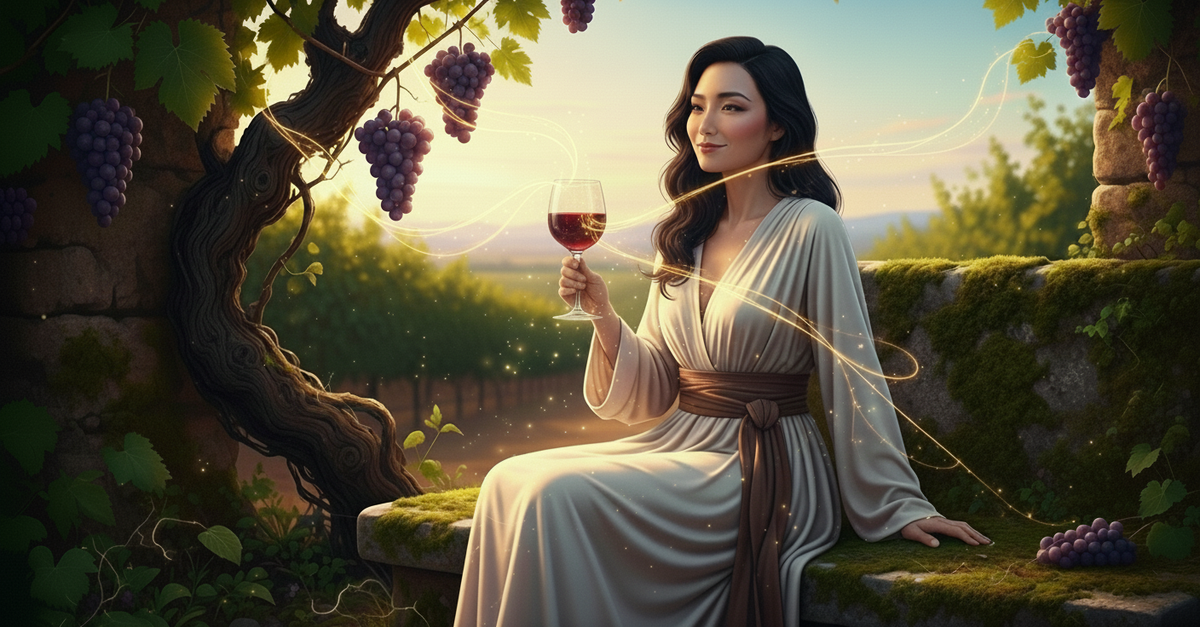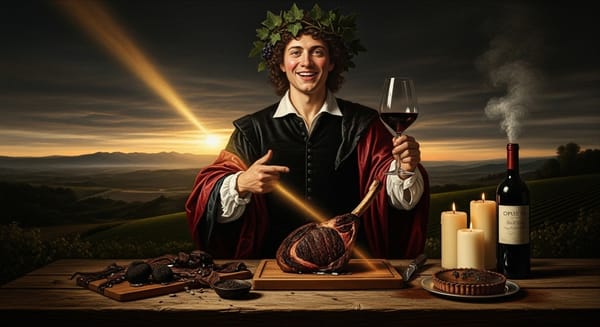Rioja: A Wine of Iron, Velvet, and Endless Memory
Rioja is an emotionally textured journey into Spanish wine, balancing lyrical storytelling with substantive content on Tempranillo, Gran Reserva, barrel aging, and the diverse subzones. Discover how tradition and reinvention forge a wine of profound resilience.

The land of Rioja is a meditation on endurance. When the long summer finally loosens its grip, the vineyards exhale a deep, complex scent—sun-baked clay mixed with the sharp clarity of crushed rosemary and the ancient, metallic tang of iron. This region is born of tension, where the vast, blue-shadowed plains meet the dramatic, limestone-hewn peaks of the Cantabrian Sierra. This implacable mountain guardian deflects the Atlantic’s damp breath; days build flavor while cool, elevated nights safeguard acidity.
To drink Rioja is a profound gesture of holding that tension. The wine carries the immense weight of history in its dark, shimmering body, a liquid memoir of scarcity and survival. It reminds us that beauty is forged in struggle, visible in every gnarled, patient vine and in the long, melancholic shadows they cast—a landscape that feels simultaneously grounded in rock and utterly eternal.
Echoes in the Stone: A Timeless History
Rioja's story is less a straight line and more a series of dramatic bends. Its foundational memory stretches back to Rome, evidenced by ancient paths and a clear acknowledgment that the Ebro held potential deeper than simple cultivation.
The true definition of modern Rioja arrived in a surge of desperation and genius in the 19th century. When phylloxera drove French winemakers southward, they arrived as refugees seeking stable ground, bringing a sophisticated, Bordeaux-influenced philosophy: small barrel regimes, meticulous blending, and a deep reverence for cellar refinement. This encounter was a cultural lightning strike, instantly elevating the local grape to a global standard. The long, horizontal cellars—the bodegas—remain spiritual monuments to that collaboration, their walls absorbing time.
Yet, this renaissance was followed by the long, dry quiet of the mid-20th century. The Franco era acted like sediment, sealing the region off from global trends. Paradoxically, this isolation became an act of unintentional preservation. Rioja’s leading houses simply continued their slow, unhurried rituals: the reliance on local cooperages, the commitment to long, oxidative barrel aging, and the patient belief that wine must be released when it is ready to speak, not when the market demands it. The wine of this period tastes of endurance, a dark, stoic companion to a generation’s grief. The postmodern rebirth, arriving with democracy, did not erase this; it simply opened the door, allowing light to reveal the deep-seated character preserved through habit.
The Geography of Longing: Terroir in Three Acts
Rioja’s physical diversity is a set of three distinct emotional registers, defined by their relationship to the Ebro and the mountains.
Rioja Alta: The Measured Cadence
To the west, Rioja Alta catches the residual chill of the Atlantic’s breath. The soil here is dense, a mix of red clay, iron, and alluvial silt—a deep, complex layer left by the river’s ancient passage. Wines from the Alta possess a structure that is distinguished and profoundly reserved. They speak in a measured cadence, a slow, building intensity that matures with dignity, carrying the cool, persistent ache of longing under a vast sky.
Rioja Alavesa: The Electric Tension
Climbing sharply toward the Cantabrian barrier, Rioja Alavesa shifts to small, fractured parcels of pale, chalky-white calcareous clay. This unforgiving ground stresses the vines, forcing roots to delve deep through the rock. This struggle yields grapes with intense, electric acidity. The wines of Alavesa are sharp, clear, and focused, like light reflecting off a newly struck bell. They carry the tension of the mountain wind, possessing a bright, linear vitality.
Rioja Oriental (Baja): The Generous Heart
Further east, embracing the dry, consistent heat of the Mediterranean influence, is Rioja Oriental. This is the sun’s dominion, a region of terracotta earth. The warmth here ensures profound ripeness, and the wines are inherently more generous, their power delivered with broad, opulent shoulders. They carry the slow, steady burn of the Spanish sun, speaking of heat and an earthy, deep-seated generosity.
The Elder Vines: Viticulture as Care
The true character of the region is rooted in the age of its vines. Many of the finest plots are planted as bush vines (en vaso), which look like twisted, ancient sculptures shaped by centuries of wind. These vines are the elders of the field, their roots extending down into the deep rock layers, granting them profound resilience.
They are pruned by intuition, by farmers who have inherited the delicate dialect of the vine. The yields from these old vines are meager, a small, concentrated toll. But in that scarcity lies the power—a small cluster holds a distilled essence of memory. The labor here is rooted in melancholy reverence: the farmer tends a legacy. The harvest is often completed by hand at quality-focused estates, a profound, seasonal rite, the final act of human intention before the grapes are surrendered to the cellar’s darkness.
The Dark Geometry: Grapes Embodied
Rioja is defined by the essential dialogue between its grapes, a masterful red quartet of Tempranillo, Garnacha, Graciano, and Mazuelo (Carignan).
Tempranillo is the quiet, dark architect. Its essence is iron beneath velvet. Its texture grants the wine its long, reflective life, giving classic Rioja its aromatic profile of faded leather, cold earth, and tobacco leaf, a quiet grandeur.
Garnacha (Grenache) is the region’s hidden flame. It burns slow and hot, responsible for the blend’s volume and generous spirit. It brings a sudden, intoxicating rush of baking spice, wild mountain herbs, and deep red fruit—the necessary, exuberant flash.
Graciano provides the essential, high-wire tension. It is the sinew and the nerve, an assertive acidity that refuses to let the wine grow complacent. It imparts a dark, compelling perfume of black pepper and violet, ensuring longevity.
Mazuelo (Carignan) completes the dark geometry. It contributes firmness and color, often acting as a silent, powerful anchor, adding an extra layer of structural density that ensures the blend's long journey through time.
The story is completed by the evolving face of white Rioja, typically driven by Viura (Macabeo) and Malvasía. The new generations have been allowed to speak with sharp clarity, carrying the scent of mountain flowers and wet stone—wines that are crystalline and ephemeral.
The Time Machine: Winemaking and Evolution
A great bodega is a subterranean sanctuary of time, where the philosophical divide between tradition and reinvention plays out.
The classical tradition dictates unwavering patience, favoring extended aging in American oak, which historically lent a comforting, canonical signature of vanilla, coconut, and dill spice. These wines, the old-school Gran Reserva, embrace the oxidative structure. The barrel acts as a time machine, allowing the wine to shed its arrogance, emerging with a burnished, quiet wisdom that favors tertiary complexities.
The modernists seek to capture the immediacy of the site, believing the soul of the vineyard should dominate. Their cellars might favor French oak or drastically reduce time in wood, prioritizing the pure, clean echo of the fruit and the mineral definition of the terroir. This tension between the barrel aging tradition and site expression is the region’s creative engine.
The Voices of the Land: Notable Producers
The legacy of Rioja is carried in the hands of its keepers. A visit to López de Heredia Viña Tondonia is a spiritual encounter with the past. The cellars are cathedrals of slow time, their air heavy with the scent of damp stone and decades-old oak. To drink their wine is to feel the full, beautiful weight of memory, preserved against all odds.
In stark contrast, producers like Artadi and Contador represent the ecstatic, visionary voice of reinvention. They focus obsessively on the singularity of the vineyard, isolating small, high-altitude parcels to express maximum potential. Their wines possess an intense, vivid clarity, a refusal to be muted, showing that this ancient land can still yield wines of ferocious, youthful power, focused on Tempranillo purity.
The essential, quiet voices of small growers, such as Remelluri in the high hills of Rioja Alavesa, remind us that the region’s strength lies in the intimate, enduring relationship between a single family and a fragile plot of ground.
The Philosophy of Keeping Time: Aging and Service
Rioja evolves like a story told in chapters that move from youth to silence. The classification system—Crianza (2 years aging, ≥1 in oak), Reserva (3 years aging, ≥1 in oak), and Gran Reserva (5 years aging, ≥2 in oak)—is a rigid philosophy of time. Gran Reserva is the zenith of this commitment, requiring the longest time in the bodega—an act of deep faith in the wine’s ability to take on the complex perfume of age: leather, dried mushroom, and a pervasive calm.
Serving these wines is a necessary ritual for unlocking that preserved time. Mature Spanish wine is best served at approximately 16–18 °C (60–65 °F). Decanting is primarily for the gentle removal of sediment, not aggressive aeration, allowing the complex tertiary aromas to rise. Aging a bottle of Rioja is an act of care, a quiet, intentional preparation for a future moment of reflection.
Time in Glass: Investment and Reflection
Rioja presents a remarkable truth: genuine, profound age-worthiness does not yet demand an obscene price. The investment philosophy here is less about profit and more about curating a personal, liquid library of time. The greatest value lies in the rarity of a perfectly stored, older vintage, particularly a traditional Gran Reserva from a profound year, whose existence is a physical tether to a bygone era.
The growing global attention on single-site, high-altitude Rioja is drawing collectors toward the specific, expressive voices of the best Rioja producers. To invest in Rioja is to secure a future moment of quiet contemplation, a chance to open a bottle and find that the wine has kept faith with the memory of the sun, the stone, and the patient hands that made it decades ago.
The River Moves On
To stand in the vineyards of Rioja is to feel the air move with the dual tones of melancholy and awe. The past lives in the ancient, gnarled bush vines and the heavy scent of American oak, a dignified presence that speaks of endurance. The future rushes in with the high-altitude air of the Alavesa, a crystalline clarity that promises renewal. This is a region of profound resilience, where the human touch has always been less about domination and more about quiet, long-term collaboration.
The final taste of a great Rioja is one of profound reverence. It is a reminder that the world’s most beautiful expressions are often found in the tension between what was and what can still be, a dark, complex liquid that keeps the memory of sun, stone, and silence alive on the tongue.





